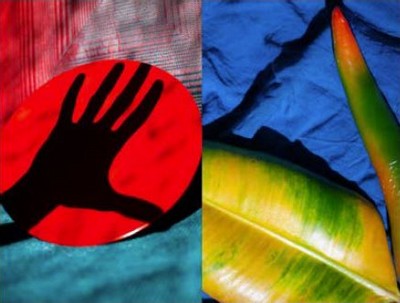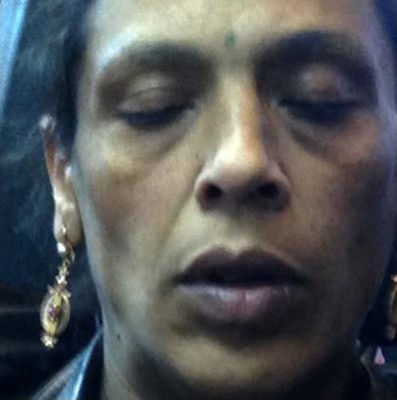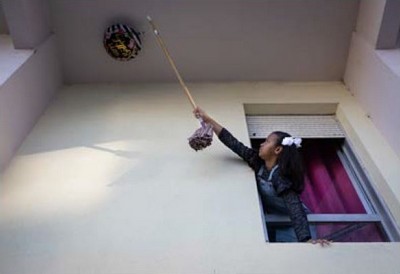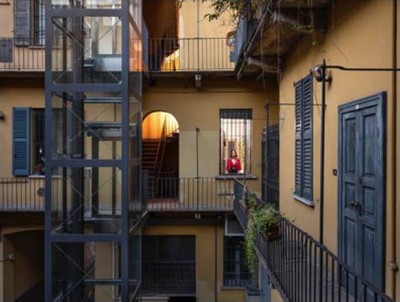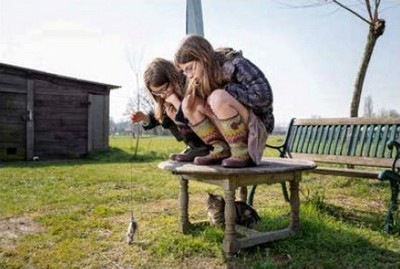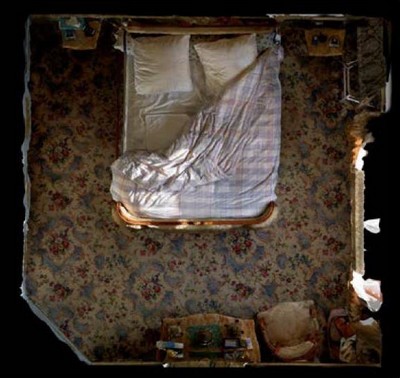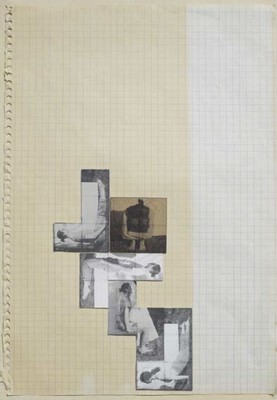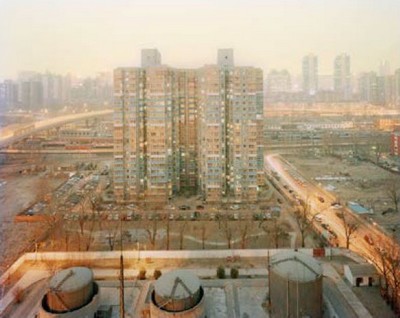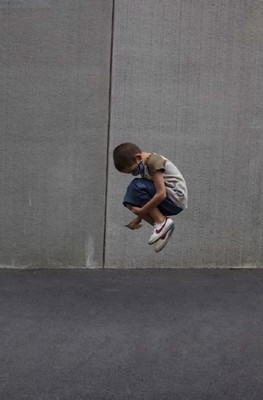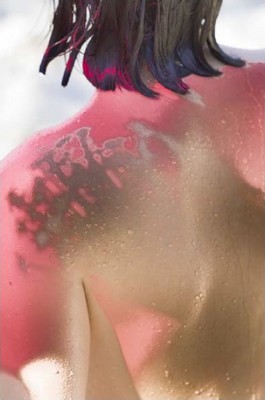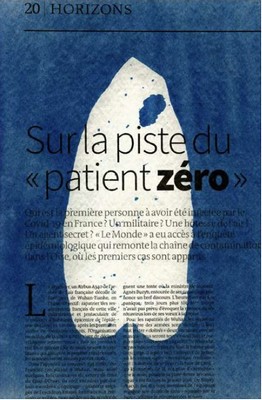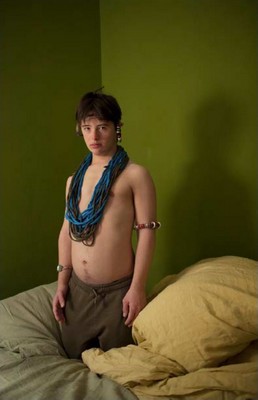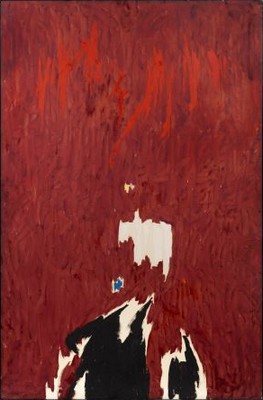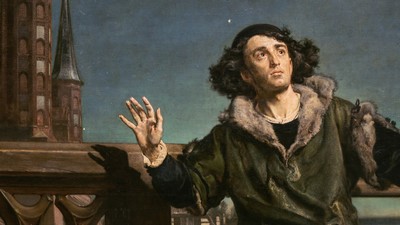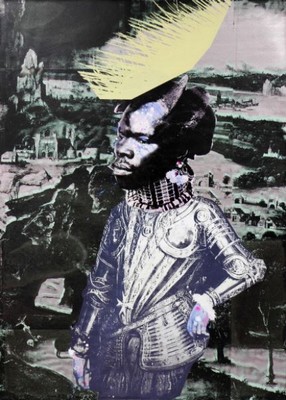PhotoBrussels Festival 05
The World Within
Hangar, Bruxelles
21 Janvier - 27 Mars 2021
Après le succès de la 4ème édition en 2019, Hangar, le centre photographique de Bruxelles lance la 5ème édition de PhotoBrussels Festival. Depuis sa création en 2016 par Delphine Dumont, PhotoBrussels Festival se déploie sur les 1000 m2 du Hangar avec une exposition thématique et propose un parcours photographique dans la ville (35 lieux) ainsi que différents évènements (conférences, workshops…). Hangar a ainsi accueilli une première édition sur le thème du paysage (« Landscape », 2016 ) et successivement mis en avant le portrait (« Portrait », 2017), la ville (« City », 2018) et la nature morte (« Still Life », 2019).
PhotoBrussels Festival 05 fera mémoire de l’année 2020 : 420 artistes confinés en Europe ont répondu au « Call for European Photographers » lancé pendant le confinement (mars-juin 2020). Un jury d’experts a sélectionné vingt-sept projets lauréats qui seront présentés au Hangar : une mission photographique comme souvenir et une scénographie immersive rappelant la condition de « confiné ».
A travers vingt-sept sensibilités photographiques et/ou vidéographiques différentes, Hangar dévoile les germes de la résilience humaine. Chaque artiste présente sa vision du « monde intérieur », faisant ainsi voler en éclat l’univers pesant de la quarantaine. Créativité, humour, empathie, réflexion, amour, inspiration de la nature sont autant de principes promettant une guérison rapide et un « après » meilleur.
Le lauréat du « Coup de coeur Leica » (choisi parmi les sélectionnés) recevra un Leica Q2 le jour du vernissage.
Comme le souligne la directrice de Hangar, Delphine Dumont : "Au jour d’aujourd’hui, alors que le « semi- lock down » et la privation de liberté sont devenus notre quotidien, nous mesurons à quel point, les artistes sont nos alliés dans l’épreuve. Leur regard sur le monde nous soutient, est comme un miroir à travers lequel s’expriment nos tensions, nos angoisses, nos joies, nos espoirs."
Les membres du Jury
Giovanna Calvenzi, éditrice et curatrice (IT)
Christian Caujolle, écrivain, curateur et critique d’art (FR)
Rodolphe de Spoelberch, fondateur Hangar et collectionneur (BE)
Bruno Devos, éditeur et directeur Stockmans Art Books (BE)
Delphine Dumont, directrice Hangar et fondatrice PhotoBrussels Festival (BE)
Gaëlle Gouinguene, communication et responsable projets culturels Leica (FR)
Organisé chaque année par Hangar, PhotoBrussels Festival c’est
- une grande exposition thématique au Hangar ;
- un Festival Tour*, un parcours dans la ville recensant toutes les expositions photos du moment ;
- un programme d’évènements : conférences, workshops, visites guidées, signatures de livres, lectures de portfolios, etc ;
- une publication* comme archive visuelle vendue en ligne et dans le bookshop.
* Festival Tour
Le PhotoBrussels Festival se déploie dans différents lieux de la capitale grâce au Festival Tour et fait ainsi vibrer Bruxelles au rythme de la photographie. Le Festival Tour répertorie toutes les expositions et initiatives liées au médium photographique pendant la période du festival. Equipé d’un plan de Bruxelles, le public est invité à passer d’une exposition photographique à une autre, dans des lieux d’art emblématiques ou des espaces moins connus, dont Hangar est le point de départ. Cette année, font partie notamment des lieux importants tels que Bozar, Botanique, Wiels, Le Musée Juif de Belgique, Contretype, ADAM Design Museum mais également des jeunes lieux tels que Geopolis ou L’Enfant Sauvage.
* Publication The World Within
Le livre révèle l’exceptionnel travail créé par des photographes confinés en Europe durant le premier lockdown de la pandémie COVID-19. Cette archive visuelle peut être commandée dès maintenant en ligne sur le site du hangar.art
23 x 29 cm, 312 pages, 524 illustrations couleur
€ 45,00 (prévente: € 39,00) - ISBN 978-2-9602519-1-3
Textes en anglais
© Hangar, Bruxelles
Les vingt-sept artistes sélectionnés
Gérome Barry
“Ce soir je vais à l’opéra dans mon salon”
Photo extraite du court métrage “Films as an escape”, 2020
© Gérome Barry, 2020
Né en 1984 en France. Vit et Travaille à Paris.
Gérome Barry a étudié les sciences politiques avant d’entrer à l’école de cinéma La Fémis à Paris. Il produit une dizaine de courts métrages, primés dans des festivals internationaux. Tout en travaillant pour la société de production Moby Dick Films, il réalise trois courts métrages : The Big Musical Number, Séraphin et Suicide Express. Il termine actuellement son premier long métrage, Swing Rendez-Vous.
Lucile Boiron
“Mise en Pièce”, 2020
© Lucile Boiron, 2020
Née en 1990 à Paris, France. Vit et travaille à Paris.
Lucile Boiron étudie les Arts Appliqués à Nantes avant de se tourner naturellement vers la photographie lorsqu’elle entre à l’Ecole Nationale Supérieure Louis-Lumière (Paris). En 2019, elle remporte le Libraryman Prize et publie son premier livre, Womb. Le livre est présenté lors de la Foire du livre d’art de New-York (2019), puis exposé dans le cadre de la triennale New Visions (Oslo). Travaillant comme coloriste, Lucile Boiron se concentre sur la chair et les angles. Loin de vouloir provoquer la répulsion, elle questionne, par la photographie, la vérité biologique du corps ainsi que la question du bon et du mauvais goût. Son oeuvre fait partie du Fonds municipal d’art contemporain de Paris (FMAC).
Marguerite Bornhauser
“Quarantine Journal”, 2020
© Marguerite Bornhauser, 2020
Née en 1989. Vit et travaille à Paris, France.
Après des études de lettres et de journalisme à la Sorbonne (Paris), Marguerite Bornhauser intègre l’École nationale supérieure de photographie d’Arles et obtient son diplôme en 2015. Son travail a été exposé notamment à la MEP (Paris), Paris Photo (Paris, 2019), Musée d’art de Cincinnati (Cincinnati), Festival de la photographie (Arles), Festival Planches Contact (Deauville), Agnès B. (Paris), Festival MAP (Toulouse), au musée des sciences (Londres). Son premier livre auto-édité, Plastic Colors, a été sélectionné parmi les finalistes du Mack Books Award en 2015. Elle collabore avec des magazines et journaux français et internationaux et travaille aussi comme photographe de mode.
Ferhat Bouda
“Frankfurt Airport, 21 March 2020”, 2020
© Ferhat Bouda, 2020
Né en 1976 en Algérie. Vit et travaille en Allemagne.
Ferhat Bouda a grandi en Kabylie, en Algérie. En 2000, il s’installe en France dans le but de faire un film. Il se tourne finalement vers la photographie en 2002, technique qui s’avère être à la hauteur de sa sensibilité et de son engagement. Son travail se concentre sur la préservation de la culture berbère et de ses multiples formes. Il développe sa mission photographique en France et en Allemagne, où il vit depuis 2005, mais aussi en Algérie, au Maroc, en Libye, en Tunisie et au Mali. Il est membre de l’Agence VU depuis 2014. En 2016, il remporte le prix Pierre et Alexandra Boulad (France) et bénéficie de la bourse de la Hessische Kulturstiftung (Allemagne).
Bruno Boudjelal
“30/03/2020” (série “Garder les yeux ouverts”, 2020
© Bruno Boudjelal, 2020
Né en 1961 à Montreuil, France. Vit et travaille entre l’Algérie et la France.
Bruno Boudjelal est membre de l’Agence VU. Il pratique la photographie comme un mode de vie qui interroge constamment sa propre identité et nous confronte à la nôtre. En 1993, il part sur les traces de ses origines paternelles en Algérie. Cette découverte sera le point de départ de 10 ans d’explorations très personnelles qui l’amèneront à assumer la subjectivité de son point de vue. Régulièrement publié dans la presse, lauréat de bourses institutionnelles et de prix prestigieux - dont le prix Nadar en 2015 pour son livre L’Algérie, clos comme on ferme un livre ?, Bruno Boudjelal a publié six monographies. Ses oeuvres sont entrées dans les collections publiques françaises et font l’objet de nombreuses expositions en France et dans le monde. En plus de sa pratique photographique, il est également curateur et réalise des vidéos, des installations et des workshops.
Sarah Bouillaud
“Day 31. Find some allies”, 2020
© Sarah Bouillaud, 2020
Née en 1985 à Paris. Vit et travaille à Paris, France.
Sarah Bouillaud est photographe et illustratrice indépendante. Titulaire d’un Bachelor en photographie de l’ICART Paris, elle travaille désormais sur différents projets en photographie et photomontage pour des journaux français (Libération, Les Echos, Le Monde, La Croix). Lauréate de SFR jeunes Talents 2013, elle participe en 2017 au Festival Les Rencontres Photographiques du 10ème à Paris. En 2019, son oeuvre Odissea a été présentée à la projection de Voies Off d’Arles. Elle est membre du Studio Hans Lucas.
Jean-Marc Caimi & Valentina Piccinni
“Sofia”, 2020
© Caimi & Piccini, 2020
Lui est franco-italien, elle est italienne, ils collaborent depuis 2013.
Ils travaillent sur des projets documentaires et photographiques, avec une attention particulière sur l’aspect humain et personnel pour chacune des histoires. Leur travail est régulièrement présenté dans la presse et les médias du monde entier (Der Spiegel, Politico, Le Monde, L’espresso, Internazionale, Wired, GQ, Newsweek, The Sunday Times). Ils sont lauréats de plusieurs prix tels que le PHmuseum Of Humanity Grant 2020 dans la catégorie exposition personnelle, le Sony World Photography Award 2019 dans la catégorie «Discovery», le prix du livre photo d’Istanbul 2018, le prix Gomma Grant 2016 du meilleur documentaire en noir et blanc. Ils sont exposés dans toute l’Europe et l’Asie, notamment à la Biennale Für Aktelle Fotografie (Mannheim), au Delhi Photo Festival (Delhi), au Lumix Festival (Hanovre), Fotoleggendo (Rome), Phest (Monopoli), Voies Off (Arles). Ils ont déjà publié cinq livres dont certains ont reçu des prix.
Gonçalo Fonseca
“Fatima” (série “Squatting Moms”), 2020
© Gonçalo Fonseca, 2020
Né en 1993 au Portugal. Vit et travaille à Lisbonne.
Gonçalo Fonseca est un photographe documentaire, explorant les sujets du logement et des droits de l’homme. Il photographie depuis son adolescence et découvre au fur et à mesure le pouvoir de la narration. Après des études de journalisme à l’Université catholique de Lisbonne (2011-2014), il décide de poursuivre sa passion et de se consacrer à la photographie. En 2015-2016, il étudie le photojournalisme à l’Université autonome de Barcelone. Ses projets sont lauréats du prix Allard pour l’intégrité internationale (2019) et du prix Young Talent at Educating the Eye (2019). Il est publié par certains des plus grands magazines et journaux du monde tels que TIME, Washington Post, Der Spiegel, El País, entre autres. Il parle régulièrement de son travail lors de conférences comme TEDx à Lisbonne en 2019.
Julia Fullerton-Batten
“Penelope” (série “Looking out from Within”), 2020
© Julia Fullerton-Batten, 2020
Née en 1970 à Brême, Allemagne. Vit et travaille au Royaume-Uni (depuis 1986).
Après avoir terminé ses études, elle a étudié la photographie et assisté des photographes professionnels pendant cinq ans. Photographe professionnelle depuis 2001, Julia Fullerton-Batten a déjà réalisé 13 projets majeurs. Au début de sa carrière, la National Portrait Gallery de Londres lui a demandé de photographier les portraits de seize personnalités du service de santé britannique, ces portraits font partie de leurs collections. Ses oeuvres sont exposées dans le monde entier et ont reçu de nombreux prix. Ambassadrice Hasselblad et conférencière, Julia Fullerton-Batten a publié deux livres. Ces projets explorent les thèmes tels que la cécité, la figure idéale dans la société moderne, l’industrie du sexe et sont guidées par l’hyper-réalisme et le cinéma. Elles placent souvent ses modèles dans des décors surréalistes et utilise un éclairage dramatique pour créer à la fois tension et mystère.
Gabriele Galimberti
“Rebecca Casale”, 2020
© Gabriele Galimberti, 2020
Né en 1977 dans le Val di Chiana, Italie. Vit et travaille à Milan.
Gabriele Galimberti a passé ces dernières années à travailler sur des projets de photographie documentaire à travers le monde, dont certains sont devenus des livres. Son travail consiste principalement à raconter les histoires, à travers des portraits et des nouvelles, d’habitants du monde entier. Il s’engage dans la photographie documentaire après avoir débuté en tant que photographe commercial et après avoir rejoint le collectif artistique Riverboom. Il travaille aussi pour des magazines et journaux internationaux tels que National Geographic, The Sunday Times, Stern, Geo, Le Monde, La Repubblica et Marie Claire. Ses photos ont été exposées notamment au Festival Images (Vevey), aux Rencontres de la Photographie (Arles) ou au célèbre musée V&A (Londres). Il remporte le prix Fotoleggendo Festival (Rome) et le prix Best In Show au New York Photography Festival.
Nick Hannes
Série “An Unexpected Lesson in Joy”, 2020
© Nick Hannes, 2020
Né en 1974 à Anvers, Belgique. Vit et travaille à Ranst, Belgique.
Nick Hannes a étudié la photographie à l’Académie royale des beaux-arts (KASK) à Gand où il est aujourd’hui enseignant. Après 8 ans en tant que photojournaliste, il décide de se concentrer sur des projets documentaires autoinitiés à l’orientation socio-politique. Utilisant l’humour, l’ironie et les métaphores visuelles, il se concentre sur la relation problématique entre l’homme et son environnement. Nick a publié 3 livres dont l’un, intitulé Garden of Delight, a reçu le Magnum Photography Award en 2017 et le Zeiss Photography Award en 2018. Nick Hannes a exposé au FotoMuseum, (FOMU, Anvers), De Garage (Mechelen), Fotofestiwal (Lodz), Organ Vida (Zagreb), Photolux (Lucca), Centro Andaluz de la Fotografia (Almeria), Triennale de la photographie (Hambourg), ImageSingulières (Sète), Photomed (Beyrouth), Lianzhou Foto Festival.
Giovanni Hänninen
“Via Madonnina - Milano - April 2020”, 2020
© Giovanni Hänninen, 2020
Né en 1976 à Helsinki, Finlande. Vit et travaille à Milan, Italie.
Giovanni Hänninen est docteur en ingénierie aérospatiale à Milan et enseigne la photographie d’architecture au Politecnico de Milan. Depuis 2009, il est photographe pour l’orchestre Filarmonica della Scala. En 2012, il est présenté par Gabriele Basilico dans l’exposition 20X20. En 2015, il participe à la Triennale Off (Milan). La Fondation Josef et Anni Albers l’invitent à photographier sa propre résidence d’artiste au Sénégal et ses photos sont présentées chez David Zwirner (2017, New York). En 2018, il expose un projet à Biennale d’art de Dakar et à Paris pour la Nuit Blanche. En 2019, il expose dans divers lieux notamment la Fondazione Studio Marangoni (Florence), MACAAL (Marrakech), Fondazione Sozzani (Milan), AKAA Paris lors de la foire AKAA, BAM (Palerme). La même année, il développe une campagne photographique pour le Complesso Museale della Pilotta pour la ville de Parme, nommée capitale de la culture.
Philip Hatcher-Moore
Série “It is solved by walking”, 2020
© Philip Hatcher-Moore, 2020
Né en 1982, au Royaume-Uni. Vit et travaille au Pays de Galles.
Avant une carrière en photographie, Philip Hatcher-Moore étudie l’informatique à l’Université de Sheffield, où il commence un doctorat en Intelligence Artificielle, avant de prendre un poste de technicien directeur d’une start-up Internet à Paris. Philip Hatcher-Moore est basé au Kenya durant 5 ans, où il couvre des sujets politiques, sociétaux et de conflits. Depuis son retour au Royaume-Uni en 2016, ses travaux se concentrent surtout sur la relation de l’homme à son environnement. Son travail est publié dans de grands journaux et magazines du monde entier, du New York Times à Vanity Fair. Il reçoit des prix lors de grands concours internationaux de photojournalisme et est exposé à travers le monde.
Pierre Jarlan
“ Roger, 95 ans. Bordeaux”, 2020
© Pierre Jarlan, 2020
Né en 1983 en France. Vit et travaille à Paris.
Pédopsychiatre et photographe, Pierre Jarlan a un parcours pour le moins atypique. De 2009 à 2011, il est l’assistant du photographe Jean-François Rauzier, avec qui il collabore pour des expositions. En 2011, il fait une résidence à la School of Visual Art (New York). Il a exposé notamment en France et aux Etats-Unis. Passionné de technologie, il crée des dispositifs de production d’images pour explorer le quotidien, mêlant objectivité de la vision scientifique et rencontre humaine et artistique.
Kíra Krász
“Composite 3” (série “Squaring each other to fit”), 2020
© Kíra Krász, 2020
Née en 1995 en Hongrie. Vit et travaille à Brighton, au Royaume-Uni.
Kíra Krász est diplômée en 2019 de l’Université de Brighton en photographie. Ayant principalement exposé en Angleterre et en Hongrie, son travail se concentre sur l’interaction entre les images et leurs propriétés physiques. Elle explore les possibilités de la photographie en expérimentant les techniques d’impression, la superposition, les textures et l’installation. Elle recadre et découpe des images imprimées, qu’elle re-contextualise. Son objectif est d’atteindre un état d ’« intemporalité » en matière de création d’images, que ce soit en choisissant des papiers vieillis, en travaillant avec des techniques traditionnelles en chambre noire ou en utilisant le jet d’encre et l’impression avec des matériaux incompatibles. Le portrait, l’abstraction, les paysages et les nus ont une importance égale dans sa pratique.
Yann Laubscher
Série “ La Baumette”, 2020
© Yann Laubscher, 2020
Né en 1986 en Suisse. Vit et travaille à Lausanne.
Après avoir étudié les sciences naturelles, il se forme à la photographie à l’Ecole des Arts Appliqués de Vevey. Il rédige sa thèse sur le lien entre exploration et photographie. Son approche documentaire se concentre sur la relation entre les humains et la nature. Son travail est exposé en Suisse, France, Serbie et Russie. Il reçoit le Prix Clara Camera pour son travail The Call. En 2016, il est lauréat du Globetrotteur World Photo dont la bourse lui permet d’entreprendre un projet en Sibérie. Il est également en charge de l’éducation environnementale à La Maison de la Rivière, il est éducateur de la nature et membre de NEAR and Strates, association incluant plusieurs photographes.
Lucas Leffler
Série “Home-Play”, 2020
© Lucas Leffler, 2020
Né en 1993 à Gaume, en Belgique. Vit et travaille à Bruxelles.
Lucas Leffler a obtenu une licence en photographie à HELB (Bruxelles) qu’il a complété par un Master à KASK (Gand). Son parcours artistique se concentre sur la dimension technique de la photographie à laquelle il intègre une dimension expérimentale. Son travail a été exposé à Contretype (Bruxelles), à la Galerie Satellite (Liège) et sera présenté au Musée de l’Elysée (Lausanne) pour l’exposition reGeneration4, ainsi qu’à l’Espace PINGUIN (Bruxelles). Son livre Zilverbeek a été publié à l’automne 2019.
Edgar Martins
Série “The strange case of Achilles and the Tortoise”, 2020
© Edgar Martins, 2020
Série “The strange case of Achilles and the Tortoise”, 2020
© Edgar Martins, 2020
Née en 1977 à Évora, Portugal. Vit et travaille au Royaume-Uni.
Edgar Martins grandit en Chine où il publie son premier roman. En 1996, il déménage au Royaume-Uni où il obtient un BA en photographie au London Institute et une maîtrise en beaux-arts et photographie au Royal College of Art. Il est doctorant à l’Université de South Wales. Son travail fait partie de diverses collections à travers le monde, telles que celles du V&A (Londres), du National Media Museum (Bradford, Royaume-Uni), du RIBA (Londres), du Dallas Museum of Art (États-Unis); Museu Calouste Gulbenkian / Modern Art Center (Lisbonne), MAAT / EDP (Lisbonne), Fondation Carmignac (Paris), MAST (Italie), etc. Il reçoit, avec son premier livre, le Thames & Hudson et le prix d’art du livre de la RCA Society. Entre 2002 et 2018, Edgar Martins publie diverses monographies. Ces oeuvres sont exposées dans de prestigieuses institutions à New York, San Diego, Rome, Lisbonne, Rio, Londres, Dublin, Séoul, etc. Edgar Martins reçoit de très nombreux prix pour son travail et est sélectionné pour représenter Macao (Chine) à la 54e Biennale de Venise.
Alisa Martynova
Série “Sleeping Pill”, 2020
© Alisa Martynova, 2020
Née en 1994 à Orenbourg, Russie. Vit et travaille en Italie.
Alisa Martynova fait des études en philologie étrangère dans son pays d’origine et poursuit, en Italie, un programme de photographie à la Fondazione Studio Marangoni (Florence) qu’elle termine en 2019. Pendant ses études, elle est assistante pour le collectif Riverboom. En 2019 elle est lauréate du Premio Combat Prize et la deuxième lauréate du Premio Canon Young Photographers. Elle projette son travail lors de la soirée d’ouverture des Rencontres d’Arles. En 2019 toujours, elle est sélectionnée parmi les finalistes du Photolux Award, du PHmuseum Women Photographers Grant et début 2020, elle est sélectionnée pour participer à Giovane Fotografia Italiana, une section du Festival Fotografia Europea (Reggio Emilia) et est nominée pour le Leica Oscar Prix Barnack. Elle est actuellement membre d’une agence de photographie italienne Parallelo Zero.
Patrick Messina
Série “Bout du Monde”, 2020
© Patrick Messina, 2020
Né en 1967 à Paris. Vit et travaille à Paris.
Eclectique, Patrick Messina a un intérêt égal pour les paysages urbains, les territoires ruraux ou les portraits. Ses photos sont régulièrement exposées à travers le monde et sont présentes dans divers musées et collections privées. Il a publié quatre livres : Wayfaring, Courtes Echelles, Paris, Portait de Ville. Il est l’un des quatre fondateurs de la mission France(s) Territoire Liquide, une recherche collective sur le paysage français, initiée en 2011 et réalisée sous la direction artistique de Paul Wombell. L’oeuvre est exposée, publiée et fait l’objet d’un film.
Alice Pallot
“Suillus”, 2020
© Alice Pallot, 2020
Née en 1995 à Paris, France. Vit et travaille à Bruxelles, Belgique.
Alice Pallot a étudié la photographie à l’ENSAV La Cambre à Bruxelles. Elle a exposé sa dernière série L’Île Himero au Festival Voies Off des Rencontres d’Arles, en juillet 2018. Elle a remporté le prix Roger De Conynck avec cette série. Alice Pallot a également exposé son travail au Botanique, Galerie Été 78, La Réserve, etc (Bruxelles). Elle expose également à Paris, à l’Artothèque Benjamin Rabier dans le cadre de Japonismes 2018 ainsi qu’au festival Diep-Haven. Elle est exposée au Hangar lors du PhotoBrussels Festival 2019. Elle a deux expositions prévues en 2020, notamment à la Biennale de l’image à Liège. Son livre Land est exposé en 2019 au Fotomuseum d’Anvers (FOMU) dans le cadre de l’exposition Belgian Photobook.
Elea Jeanne Schmitter & Le Massi
Photo du court-métrage “Ode à.”, 2020
© Elea & Le Massi, 2020
Elle est née en 1993 en France. Il est né en 1989 au Canada. Ils vivent et travaillent à Paris. Ensemble, ils font des films.
Artiste plasticienne, Eléa Jeanne Schmitter obtient son BFA de l’Université Concordia en 2018. Elle présente son travail dans de nombreuses galeries à travers l’Europe et l’Amérique du Nord notamment à Montréal au Centre des Arts actuel SKOL, Le Livart et la galerie FOFA. Elle fait partie du livre On Death publié par Kris Graves Project en association avec Humble Arts Foundation. Elle est actuellement étudiante dans la section Art et Image de l’école Kourtrajme dirigée par l’artiste JR et le réalisateur Ladj Ly.
Le Massi est un artiste visuel, musicien et acteur. Il obtient en 2019 son BFA en photographie à l’Université Concordia, à Montréal. Son travail visuel a été exposé au Canada, en France, en Angleterre et aux États-Unis. En 2019, il est l’un des lauréats de Portrait of Britain.
Ensemble, ils ont eu un solo show au InCadaqués Photo Festival en October 2020.
Alexandra Serrano
“Jeudi 26 Mars 2020 - 15h30. Exposition : 47 minutes”, 2020
© Alexandra Serrano, 2020
Née en 1988 à Fontainebleau, France. Vit et travaille à Paris.
La pratique d’Alexandra Serrano est sensible et poétique. Elle aborde des thèmes tels que ceux de l’identité, de l’histoire et de la mémoire qu’elle explore à travers l’expérience physique et émotionnelle des espaces construits et investis par l’homme. Son travail figure dans diverses publications et a été exposé dans des expositions collectives et individuelles à travers l’Europe, l’Amérique du Nord et l’Asie. Ses photographies ont été montrées au Festival Circulations(s) (Paris), à Fotoleggendo (Rome) et aussi lors de la 8ème édition de Chobi Mela (Dhaka), ainsi qu’à Londres, Toronto, Portland et Boston pour le Flash Forward Festival. En plus de sa pratique artistique personnelle, Alexandra enseigne la photographie aux étudiants en BA à l’université de la Sorbonne et donne des ateliers de photographie en collaboration avec divers musées et institutions à Paris comme la MEP, le BAL, le musée Nicéphore Niepce ou le Centquatre.
Frédéric Stucin
“Rue Rambuteau/ Rue Saint Denis, Paris” (série “The setting”), 2020
© Frédéric Stucin, 2020
Né en 1977 en France. Vit et travaille à Paris.
Diplômé de l’Ecole des Arts décoratifs de Strasbourg et de l’Ecole nationale supérieure Louis Lumière, il commence à travailler comme photographe de presse en 2002. Il réalise de nombreuses commandes, pour la presse, pour des entreprises et pour des institutions. Parallèlement, il développe son travail artistique. Il expose à travers le monde, notamment en France, aux Etats-Unis et en Australie. De 2016 à 2019, il publie quatre livres.
Mattia Sugamiele
“Gate #7, 3d compositing technique on Mecca landscape image, April 07”, 2020
© Mattia Sugamiele, 2020
Né en 1984 à Erice, Italie. Vit et travaille à Milan.
Après un diplôme en production et audio vidéo à l’IED de Milan, Mattia Sugamiele développe un intérêt particulier pour la peinture et décide de s’inscrire à l’Académie Brera de Milan, où il obtient un diplôme en Arts visuels en 2016. Il participe à des expositions collectives à la First Art Biennale (Trapani, 2013), Villa Gori (Lucca, 2013), Magi Museum (Pieve di Cento, 2014), Former Studio of Piero Manzoni (Milan, 2014) et Space Rivoli 2 (Milan, 2016). Parallèlement à la pratique picturale, Mattia Sugamiele intègre la musique à la production vidéo notamment pour des projets au Meet Factory (2014), au Festival of European Photography (Reggio Emilia, 2014) et au Caf Central (Bruxelles, 2015). À partir de 2017, l’artiste se consacre entièrement à ses recherches incluant photographie, vidéo et peinture. Il participe à Photo Israel (Tel Aviv, 2017), Manifesta 12 (Palerme, 2018), Studi Festival (Milan, 2018 et 2019) et est inclus dans le collectif Kaleidoscope aux Art Warehouses (Trapani, 2019).
Simon Vansteenwinckel
“Wuhan Radiography”, 2020
© Simon Vansteenwinckel, 2020
Né en 1978, à Bruxelles. Vit et travaille à Bruxelles.
Simon Vansteenwinckel est photographe et graphiste. Fasciné par le cinéma, il réalise de nombreux reportages photo documentaires. Il est membre de l’agence Haytham Pictures de 2014 à 2015, du collectif Cyklope de 2010 à 2016, du comité de rédaction de la revue Halogénure et de l’agence Hans Lucas de 2017 à 2018. Simon Vansteenwinckel a exposé à divers endroits, notamment : Centre Rabelais (Montpellier), Voies Off (Arles), Recyclart, (Bruxelles), Festival Photo Patagonia (Rio Gallegos), Zoom Photo Festival (Saguenay), Musée de la Photographie (Charleroi), etc. Il reçoit divers prix, comme Grand Prix du public au concours Cultures on My Street (2008), Le Prix National Photographie Ouverte (2017) ou encore le Grand Prix du Jury à la 4ème édition des Nuits Photographiques d’Essaouira. Rédacteur aux éditions Le Mulet, il a déjà quelques publications à son actif.
Laure Vasconi
“Paris - 05.04.2020” (série “Léonard at Home”, 2020
© Laure Vasconi, 2020
Née en 1965, à Stuttgard, Allemagne. Vit et travaille à Paris.
Après des études d’architecture (Paris), Laure Vasconi étudie la photographie à l’ICP de New York. De retour à Paris, elle assiste quelques photographes de l’agence Magnum et réalise ses premiers projets personnels. Elle débute comme photographe indépendante en 1990, pour la presse et des institutions culturelles tout en exposant en France et à l’étranger et publie son premier livre en 1997. Elle participe à de nombreux festivals internationaux et expose dans différentes fondations, instituts, galeries, musées… Elle donne des cours d’art dans des écoles et collèges avec le Ministère de l’Education et de la Culture et participe aux Masterclasses des Rencontres de la Photographie à Arles. Intéressée par la mémoire, les archives, le territoire et l’identité, elle collectionne des images et histoires de familles. Elle travaille actuellement sur la mission photographique France(s) Territoire Liquide et Paysages Français à la Bibliothèque nationale de France.
HANGAR. PHOTO ART CENTER
Place du Châtelain 18, 1050 Brussels






